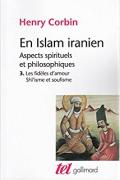En Islam Iranien, vol. 3

Aspects spirituels et philosophiques, tome III
Maybe really - as Henry Corbin remembers - it is in the ceremony of Iranian wedding that you can still detect the trace of one of the highest significance of the amorous idea of Sufism: the husband will not look at his wife directly as she enters the room, but he will scrutinize an image reflected in a mirror. In order to say that in true love, that can not be but unique and unite the simplest things to God himself, there is no possession and neither a relationship between simple objects, but a dizzying game of reflections, lights and shadows, a game whose sacred mystery is the mirror itself. The experience of love for a Sufi must be a vision of the vision and that is the teaching of the great mystic Rūzbehān Baqlī ShIīrāzī, to whom Corbin devotes the first part of this third volume of En Isalm Iranien, and it is an example of absolute spiritual research.
The second part of the book explores a problem not easily solved albeit important: the complex relationship between Shi'ism and Sufism. For the Shi'ite world the key figure is certainly that of Haydar Amoli, who spreads the theosophy of Ibn 'Arabī correcting it in the context of the imāmological doctrine. As Corbin emphasizes, he is the source and the guarantee of a true spiritual experience able to revive the revelations, even for a Sufism that often "dare not speak its name", that is its proximity or implied commitment to the principles of shī 'ism.